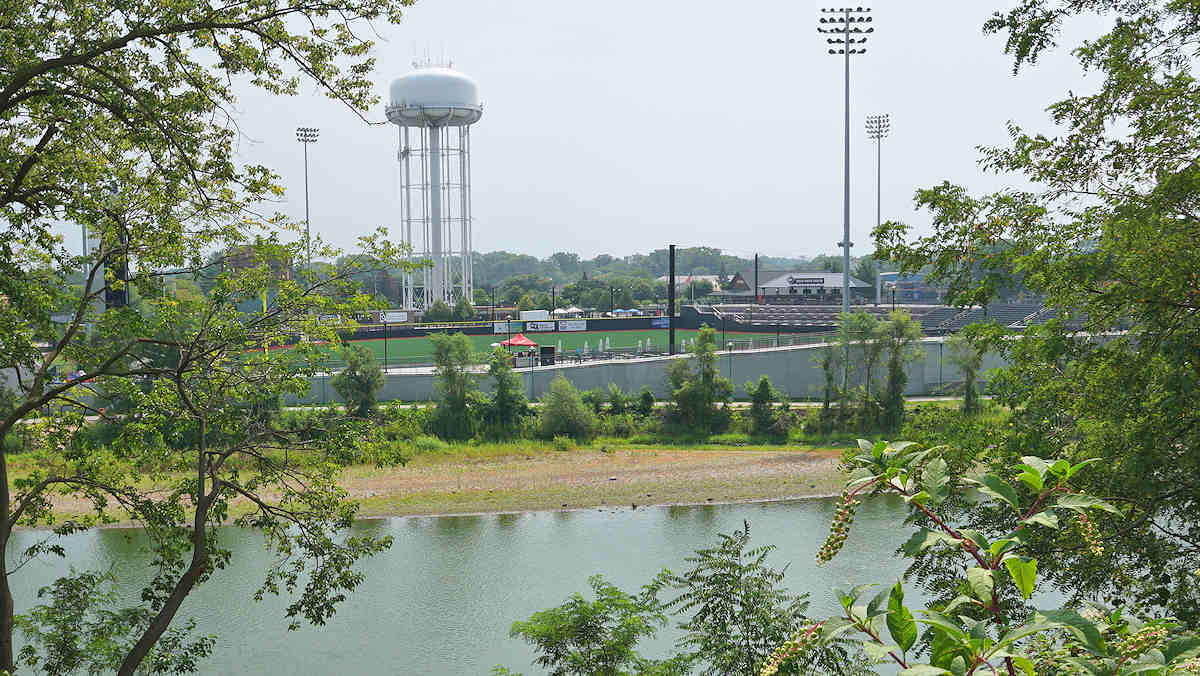
Article and photos by Joe Mock, BaseballParks.com
All rights reserved
BELOIT, Wisconsin There’s all kinds of merchandise at the Beloit Snappers’ brand-new ballpark carrying the phrase “Farewell Season.” It’s even part of the team’s logo that appears on the shiny new video board.
| Ballpark Stats |
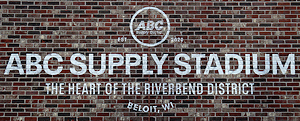 |
| Team: Beloit Snappers of the High A Central League |
| First game: August 3, 2021, a 9-5 loss to Wisconsin |
| Capacity: 3,850 |
| Dimensions: LF – 345; LCF – 378; CF – 400; RCF – 371; RF – 325 |
| Architects: Jones Petrie Rafinski — D.J. Charmet, Senior Architect |
| Construction: CCI |
| Price: $37 million |
| Home dugout: 1B side |
| Field points: northeast |
| Playing surface: FieldTurf (artificial) by Tarkett |
| Naming rights: ABC Supply Company purchased it for 20 years |
| Ticket info: milb.com/beloit/tickets/ |
| Betcha didn’t know: This is the first pro baseball stadium constructed by CCI. |
So a team tells everyone that it’s their farewell season even though they’ve just opened a miraculous ballpark that saved the franchise from extinction, and will be the home of affiliated Minor League Baseball for many years to come?
One thing you learn quickly at brand-new ABC Supply Stadium is that nothing here is how things work anywhere else. And that includes the backstory of the park, the way it was paid for, the way it was designed, the way it was constructed – even the ownership of the team. Nothing with the Beloit Snappers or their shiny new ballpark mirrors any other pro baseball franchise.
And that’s why it’s such a fascinating story to tell.
For years and years, the baseball world knew that the Beloit Snappers’ home field, Pohlman Field, was among the worst in the affiliated Minors. Built in 1982, it might’ve sufficed for an indy franchise (barely) or a summer wood-bat team, but not for the Class A Midwest League. And if you looked at the league’s attendance figures, you typically saw the Snappers trailing the rest of the pack.
Further, its location was in the middle of an older neighborhood, far, far away from the city’s core. There was no opportunity to develop restaurants or hotels. There was nothing to attract tourists or even locals to the site, and no reason for a developer to waste any time thinking about investing in the location.
Frankly, there was more excitement at the adjacent Little League field than at Pohlman.
There was no question that the market needed a new park, but the municipal government in Beloit (population 39,000) simply didn’t have the means to make it happen.
So why didn’t the owners of the team build a new park? Well, for 38 years, the franchise had been owned and operated by the Beloit Professional Baseball Association, a non-profit board made up of local residents. In the modern age of pro baseball, it was an ownership structure and ballpark arrangement that harkened back to a bygone era. It made no sense today.
In speaking with Reid Tennant, Assistant General Manager for Food & Beverage for the team, I joked that the only thing Pohlman had going for it was serving cheese curds. He corrected me. In the final year of the team’s run at that park, the curds were off the menu. “If a fan said they wanted cheese curds or fries, we told them you don’t want to eat anything that would come from the fryers there.”
So things were a mess.
| On the chopping block |
 |
| Had the Snappers failed to replace Pohlman Field, the franchise was destined to be contracted by MLB. |
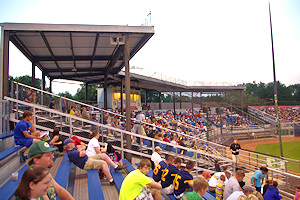 |
It came as a surprise to no one that when the first draft of teams to be eliminated in MLB’s plan to take over the governance of the Minors and streamline the number of franchises, the Snappers were on the list to be contracted.
An exceedingly small market with a woebegone park with owners who had no deep pockets, well, that probably put Beloit at the very top of the contraction list.
Normally, that would be the end of the story for baseball in Beloit. But as you’ll see, nothing happens “normally” in this tale.
There are three critically important people in this series of events: Diane Hendricks, Quint Studer and his wife Mary – much better known as Rishy.
From what I understand – and Hendricks is a very private person, so my request to interview her went unheeded – when her late husband wanted to start a roofing company back in the 1960s, his request for a loan was turned down by banks in his native Janesville, Wisconsin. Financial institutions in nearby Beloit, though, saw promise in him and loaned him the money. His business began to thrive in Beloit, and eventually he had over 500 employees. He never forgot how Beloit had given him his start in business.
Diane and Ken married in 1975, and in 1982 the two formed ABC Supply Company selling building materials for both commercial and residential buildings. The company became a huge success, and spawned a number of new ventures, ultimately resulting in Hendricks Holdings. It’s a huge firm that invests in various industrial and service-sector businesses, including Geronimo Hospitality, which as you will see, is another big part of this story.
Unfortunately, Ken died in 2007. Forbes assessed him to be the 107th richest person in the U.S at the time of his death. Diane carried on and today is the owner and chairman of the board for the firm. Hendricks’ business interests represent one of the all-time great American success stories.
But Diane Hendricks was never much of a baseball fan.
Quint Studer’s success story somewhat mirrors Hendricks’, although Studer’s rise to prominence was in the healthcare industry. Hendricks knew of Studer from his early days as a special-ed teacher and later as an executive at a hospital in Janesville.
Even though Studer’s healthcare business was based in Florida, he and Rishy kept close ties to Wisconsin. Not coincidentally, he also owns the Pensacola Blue Wahoos baseball team and built the stadium they play in today (for more on the arduous series of steps he had to go through to get an affiliated team to Pensacola, read our review of their ballpark).
So when Hendricks asked the Studers to dinner, the conversation turned to the death sentence that MLB was about to deliver to the Beloit Snappers. All of the ingredients were there: Hendricks had the financial wherewithal and the love for Beloit, and Studer had the knowhow to operate a pro-baseball team and build a new ballpark. A plan was developed.
“And so it was, with a lot of thought, that we decided to go to New York on a Tuesday afternoon and meet with Major League Baseball,” Hendricks explained to the crowd at the grand-opening ceremony for the ballpark. “We brought our architectural blueprints and basically said ‘we want to build a stadium.’ When we left there that day, I suddenly realized that if we had a stadium, we would have a team. We had to build it.”
Studer explained that a critical aspect of the pitch was that the park would be constructed entirely with private money. No haggling with city councils. No public referendums. Not only that, a well-regarded Minor League owner, Studer, would own the franchise and make it a success.
Beloit was back in the game.
Suddenly, preliminary lists of Minor League teams to be contracted no longer included Beloit.
| To the rescue |
 |
| Shown with Snappy the mascot are Quint Studer and his wife Rishy. Their firm Gateway Professional Baseball owns and operates both the Pensacola Blue Wahoos and the Snappers. |
Again, this isn’t how things normally happen in the world of pro baseball.
To make the new ballpark a reality, a 501(c)(3) non-profit entity was created to oversee the process and ultimately own the facility. It was called the Riverbend Stadium Authority, as the site chosen for the ballpark was along the banks of the Rock River where, of course, the river bends. And Hendricks insisted that the park be built with as much local manpower and building materials as possible. For instance, all 250,000 bricks used in the stadium were manufactured in Wisconsin.
And the firm doing the construction was CCI, headquartered in (of course) Beloit. And, yes, it was the very first time they’d been called on to construct a baseball park.
Remember what I keep saying: this isn’t the way things normally work.
Original estimates called for the construction to cost about $30 million, which did not include the land because the city already controlled the site. It quickly become obvious that $35 million was needed due to significant challenges with the soil and what was underneath it, plus the pandemic and its aftermath pushed the cost of construction materials through the roof. The final tally was $37 million.
The majority of the funds came from Hendricks, although she insisted that other local parties participate as well. “This didn’t just happen. The community made it happen,” said Hendricks. “I love not giving up, and this community never gave up on baseball.”
And it’s not overstating things at all that the ballpark – called ABC Supply Stadium, named for the firm that Ken and Diane Hendricks started in 1982 – saved baseball in this city. “If this stadium were not built, Minor League Baseball would never exist again in the City of Beloit,” observed Celestino Ruffini, CEO of Visit Beloit.
“We get to be part of the building of an outdoor theater, an outdoor park, an outdoor center for the community to get together,” said the CEO of ABC Supply Keith Rozolis. He added that investing in the cost of the stadium is “one of the best opportunities for ABC Supply to give back to the community that has given so much to us over the last 38 years.”
And Hendricks knew that Studer was the perfect owner for the franchise, since his Pensacola ballpark has been used for a variety of purposes beyond baseball. “We don’t have to figure out how to use the field in every way possible. (Studer) has been there. He’s doing it. And he’s going to do it again here in Beloit.”
Almost always, a new ballpark opens on (or not long after) the beginning of a season. Not here. The target date for opening was always going to be during the 2021 season, and even though ground wasn’t broken so construction could start until June 15, 2020, the facility was done in 13 months. That’s miraculous, especially considering what was going on in the world. “To be building a stadium in the middle of a pandemic, well, it’s like the wrong time,” said Hendricks. But she quickly added, “But it’s the right time.”
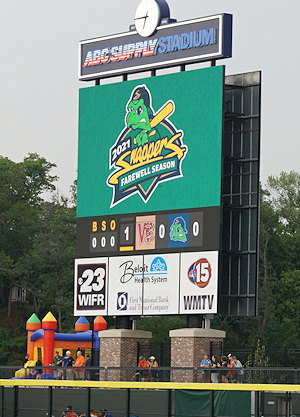 But we’re not done with the “that’s not the way things normally work” parts of the story. The logo the team is using for 2021 shows the familiar snappy turtle with the phrase “Farewell Season” (see photo). Huh? They are moving into a brand-new ballpark. Why are they saying “farewell”?
But we’re not done with the “that’s not the way things normally work” parts of the story. The logo the team is using for 2021 shows the familiar snappy turtle with the phrase “Farewell Season” (see photo). Huh? They are moving into a brand-new ballpark. Why are they saying “farewell”?
That’s because the franchise is about to go through a complete rebranding. The Snappers name will be gone, and a new one will be announced this fall. So the world is saying farewell to the Snappers name and logo, just as the team is saying hello to its new home.
“This is going to be the first rebranding of a Minor League team since MLB took over the governance of the Minors,” Studer explained. “We were originally thinking of unveiling a new nickname as the new stadium opened, but MLB asked us to wait so they can be more involved in it.” Brandiose, the creative folks who helped with the rebranding of Studer’s Blue Wahoos and many other Minor League franchises, is working on the new logo and name. And you certainly don’t want to announce a new name and cute logo and not have loads of new merchandise to sell, so that needs to be prepared before a new identity can be launched.
If the team pulls this off half as well as the Amarillo Sod Poodles, Rocket City Trash Pandas or Kannapolis Cannon Ballers, Beloit’s team will have an ultra-successful kick off.
Have fans embraced the new park? Here’s an interesting stat provided by team president Jeff Jurgella. “In 2019, there were exactly seven full-season ticket holders here, so, yeah, we had a challenge. Today we’re approaching 300.” And with a full offseason to sell ticket packages and convince more companies to become sponsors, that number will no doubt swell. “We will be contacting churches, businesses and groups of all kinds, suggesting that they bring their folks to a fun evening of baseball in this great new ballpark.”
Jurgella adds that formerly the team could only afford to have four full-time staff members in the front office. “By next spring, it will be 14.”
So the team has moved into a modern, flexible new stadium. Where exactly is it located? What does it offer fans in the way of a gameday experience that is light-years beyond what they saw at Pohlman? Read on … and expect a lot of “that’s not the way it’s supposed to work.”
The Setting
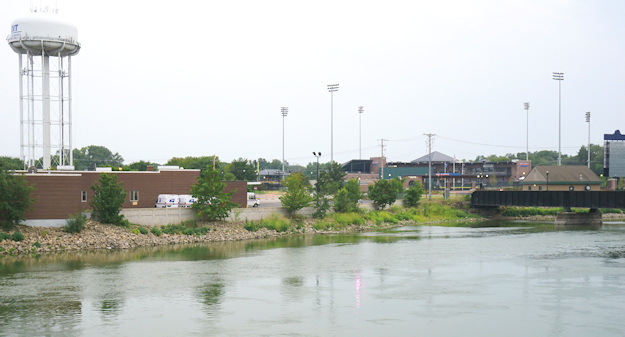
Everything about Pohlman Field’s location was wrong. But where should its replacement be? Some thought it should be closer to the larger population center of Janesville, a dozen miles north of Beloit. Others thought it should be even farther from downtown, near Interstate 90 that runs along the eastern edge of the city.
Diane Hendricks had a better idea. “We’ve got restaurants. We’ve got hotels. We’ve got great businesses. We need to create things for people to do. And that stadium will be more than baseball. It’s an economic development tool that can be greater than anything we’ve done in Beloit before.”
No sense building it out in the boonies somewhere. It needs to be right downtown. In fact, why not build it in the shadow of the massive water tower that says “BELOIT Gateway to Wisconsin”? Of course, those words are painted on the tower so they point in the opposite direction of the ballpark, but no matter. That water tower makes a tremendous landmark for the park, so if you see a TV shot of a ballpark’s outfield, and you see a massive water tower beyond right field, you’ll know it’s Beloit.
The land selected for the park has an interesting – some might say checkered — past. Because of its proximity to the river, forms of water treatment had been done here, and various kinds of companies had existed in decades past. When those companies failed or moved on, large chunks of their buildings were simply buried under tons of dirt. It made it look somewhat like a nice flat parcel of land, ready for development. But underneath lay dark secrets of the past.
Mark Hartwig, Project Manager at CCI, the firm that did the construction, explains that the remains of several buildings were found below the surface, so over 200 truckloads of debris had to be hauled off to a recycling center. Further, the ground wasn’t, uh, clean, requiring the word that construction projects fear: remediation. “22,000 cubic yards of contaminated soils, representing 1,200 truckloads, had to be removed to licensed landfills,” he reports.
With all that had transpired on the site – and the trouble it took to make it ready to build on – the ground needed to be made stable. This was accomplished with the installation of 1,400 “geo piers.” These improved “the structural integrity of the ground beneath the new construction,” says Hartwig. “The piers support the building structure, concrete concourse, ramps and field walls.”
Further, the site wasn’t very large – and the presence of the Rock River a few feet away didn’t help matters. Hartwig says that “most stadiums of this size require 11 acres. This site is seven.”

It’s also important to note what is near the ballpark site, because that is a huge part of the story. Beloit’s adorable downtown is just a couple of blocks from the park’s center-field gates. After examining this area, I concluded that it would’ve been a crime for the new park to be anywhere else in the city. Shops and eateries with outdoor seating dot Grand Avenue and State Street, a very short walk from the park.
Since Geronimo is the food-service vendor at the ballpark, I decided to eat lunch at one of the many restaurants that they operate. I picked Lucy’s #7 Burger Bar at 430 East Grand, less than three blocks from the ballpark. It was a fantastic choice, as I had a Juicy Lucy burger (that’s a big thing in the upper Midwest, where the cheese is buried in the patty before it’s cooked) with bacon, peanut butter and grape jelly on top (photo below). I’m quite sure I’ve never had a better burger, nor enjoyed the atmosphere of a restaurant more.
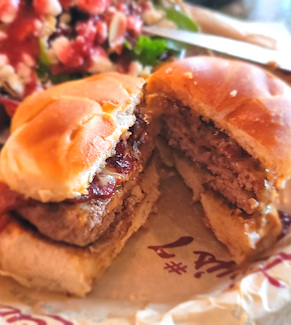 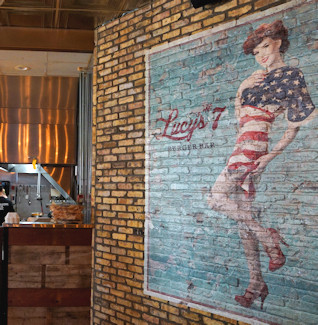 |
I spoke to Front Of House Manager Holly Schoessow-Rosario about how ABC Supply Stadium had impacted business at the restaurant in the park’s first week. She said that the flow of customers was noticeably heavier than usual through each day, and lots of the patrons were talking about the ballpark.
Another highly rated Geronimo eatery in the business district is Merrill & Houston’s Steak Joint. This upscale steakhouse is a block north of Lucy’s.
The central business district is a block from the Rock River, on its east side. Just on the other side of the river is quite a bit of new construction, including a beautiful apartment building called the Wright & Wagner Lofts. Built on the site of a former dairy, it’s managed by Hendricks Commercial Properties. It’s across Grand Avenue from the sprawling complex known as the Ironworks Campus, which is a huge success story for Hendricks. For 150 years, this was The Beloit Corporation factory, producing paper-making machinery used around the world. After it went out of business in 1999, Hendricks bought the 750,000-square-foot complex, and reimagined it into a series of smaller offices and commercial spaces. This shining example of ingenuity is upstream from the ballpark by less than a mile.
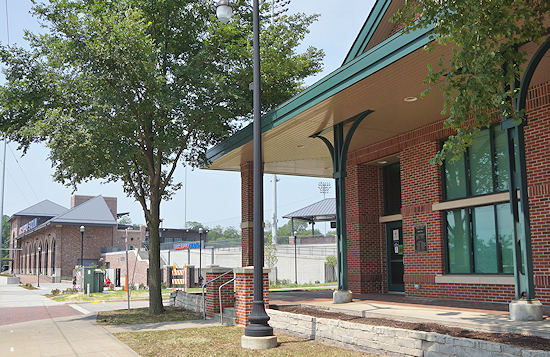
On the east side of the ballpark are city buildings and the interesting transit depot (photo above). It’s the brick of this lovely building that inspired the masonry work of the ballpark.
It’s certainly noteworthy that the Rock River flows lazily along the western perimeter of the park. You’ll have a cool view of the stadium if you cross the river on Shirland Street and take an immediate right on Bluff Street. You’ll soon come to a clearing marked by a white fence where you can gaze across the river and see the park’s outfield. It’s the scene in the photo at the top of this page.
The southern edge of the ballpark is only a couple of hundred feet from the state line between Wisconsin and Illinois. In fact, the Illinois city of South Beloit shares the state boundary with Beloit. The Snappers like to joke that a well-hit foul ball behind first base can end up in Illinois.
Memo to Beloit City Hall: paint the words “BELOIT Gateway to Wisconsin” on the opposite side of the tower, too!
The Exterior
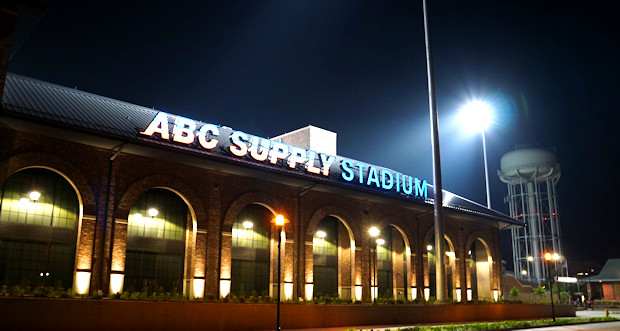
We’ve remarked several times this season that in order for a new park to be built on a budget, money has to be saved on the exterior. Brick has become frightfully expensive.
If you glance at the front of ABC Supply Stadium along Shirland Street (where you’re almost standing on the state line with Illinois), you would swear that money was in plentiful supply on this project. The brick arches are beautiful, as is the masonry surrounding the main entrance. Obviously, this flies in the face of 2021’s other new parks.
And if you happen to see it at night, you’d be blown away by the lighting around the arches (photo above) … although the portion of the building where the doors are located could use a little more illumination.
Now, one could question all of this expense because it’s all not quite as visible as it could be. That’s because the site is so tight, this front façade sits almost right on the street, meaning as you drive by, you have to turn your head to see its beauty. If there had been room to set it back from the street by, say, 75 feet or so – and maybe had a lane where fans or workers could be dropped off – it would be easier to see the beautiful edifice. Instead, it’s so close to the street that two lanes of Shirland Street had to be closed off while construction was taking place.
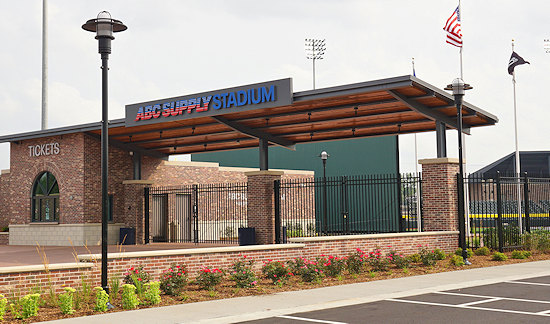
There are two sets of ticket windows at this park, and they couldn’t be farther apart from each other. One is on the river end of the main brick façade along Shirland, and the other is adjacent to the center-field entry gate (photo above), which is close to the main business district with the wonderful restaurants. This entryway, by the way, is quite wide and welcoming, with a pretty entry plaza just inside, which is just beyond the playing field’s center-field wall. Jurgella says that the team believes that about 80% of fans will enter games through this gate.
There is a third entry as well (photo below). It is on the water-tower end of Shirland. Like the main doors next to the ticket windows, it is also on street level, meaning you have to go up steps or ramps to get to the main concourse behind first base.
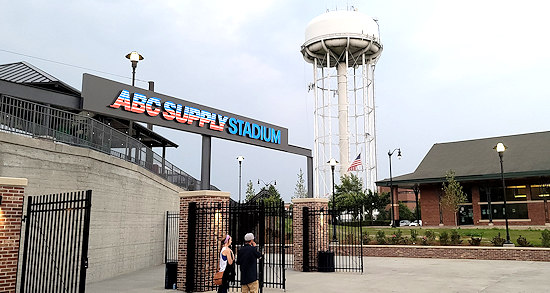
Most of the rest of the exterior is various forms of fencing, sometimes with mismatched fence types in juxtaposition (photo below). There is a solid attempt at allowing views into the ballpark along the walkway that hugs the river’s edge, as well as from the aforementioned lookout point across the river on appropriately named Bluff Street. Similarly, there are very nice views of the Rock River from within the park along the concourse between third base and left field (photo below). Humans love looking at scenes of water, and it’s nice to stop and watch the flowing river from that point of your trek around the ballpark.
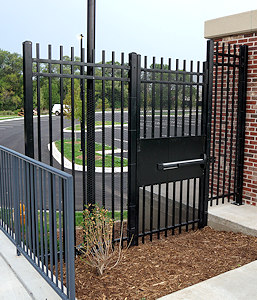 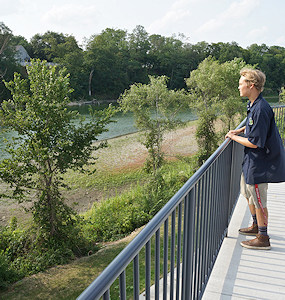 |
While not all of the exterior fencing is stunning, the landscaping is. A lot of effort was put into it, and as it grows and matures, it will be even nicer.
The parking adjacent to the park isn’t plentiful, but it is wonderfully free. There is a 148-space lot just outside the center-field gates, although it is closed when fireworks are planned for that evening. I used the lot next to the transit depot, and there are other lots and street parking in the nearby business district, all of them free to use.
The team anticipated that there would be complaints that parking wasn’t sufficient, but they didn’t materialize. “We like to survey our customers to see what they think,” Jurgella told me. “In the first 300 surveys we received after the opening of the ballpark, not one mentioned parking as being a problem.”
So the new ballpark is where it should be and its main entry is gorgeous. What is it like inside? Keep reading for the answer.